A signed path through the Palazzone Necropolis leads from the Ipogeo dei Volumni to this small museum.
Cinerary Urns
The antiquarium exhibits a number of cinerary urns from the site. Those that are described below all have reliefs that illuminate particular aspects of Etruscan culture.
Urn from the Ipogeo dei Anani (2nd or 1st century BC)
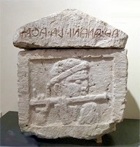
This urn is one of a number that have reliefs of scenes of Etruscan feasts, and is distinguished by a particularly animated relief of the head of a man playing a flute.
Cinerary Urn (2nd or 1st century BC)
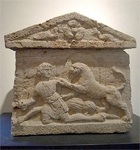
Urn of Vel Cai Carcu (2nd or 1st century BC)
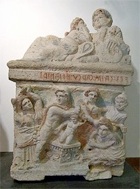
The fine relief on the front of the urn shows the hero Telephos, King of Mysia threatening to sacrifice Orestes, the young son of Agammenon and Clytemnestra. The myth relates that Achilles wounded to pro-Trojan Telephos in a skirmish when the Greek fleet landed at Mysia by mistake on their way to Troy. An oracle told him that only Achilles could heal the wound, so he seized Orestes in an effort to force him to do so. Achilles claimed that he had no medical skill but Odysseus saved the day by suggesting that the rust from Achilles sword would do the trick. It worked and, in return, Telephos guided the Greeks to Troy. In the relief, three female relatives of Orestes surround the altar as Odysseus makes his entry from the right. The lady on the left, who wields an axe, is probably Clytemnestra: this is odd because in some versions of the myth she suggested the ploy to Telephos. She did however murder Agammenon with an axe when he finally returned to Attica from Troy.
Ipogeo dei Setna (2nd – mid 1st century BC)
Eight polychrome stone urns that belonged to the Setna family were found by chance in the 1960s in a rectangular hypogeum at Ponticello di Campo, outside Perugia.
The two main urns have reclining figures of the deceased on their lids:
-
✴The urn of Vel, son of Larth (at the centre of the back wall) has a relief of the sacrifice of Iphigenia. [King Agamemnon, the leader of the Greeks sacrifices his daughter Iphigenia to placate Artemis, whom he had offended. Only then would she send the fair wind that would allow the fleet to set out for Troy.]
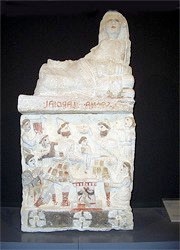
-
✴The urn of Arnth, son of Aule (at the centre of the left wall) has a relief Pelops’ murder of Oenomaus, king of Elis. [In this myth, Oenomaus routinely challenged his daughter’s suitors to a chariot race and then murdered them when they lost. Pelops avoided this fate by arranging for the lynch pin of a wheel of Oenomaus’ chariot to be removed. When the chariot overturned, Pelops completed the murder by hurling the detached wheel at Oenomaus.]
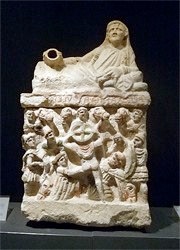
Red-figured vase (330 – 310 BC)
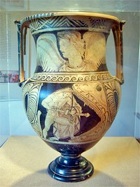
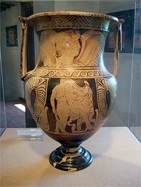
This lovely vase (two views of which are shown above) was discovered in the 19th century, but all that is known about its precise provenance is a cryptic note that says that it was found in the “Ipogeo degli Acsi”, which was discovered in the 1840s. Since the other grave goods from this hypogeum date to ca. 500 BC, the information as to the precise provenance of the vase might well be inaccurate.
The vase, which was probably made in Volterra, depicts two scenes from the myth in which Hercules rescues Hesione, the daughter of King Laomedon of Troy from a sea monster:
-
✴Hercules puts his foot on the lower jaw of the monster as he prepares to draw his sword; and
-
✴Hecules embraces Hesione, who is suitably grateful for her rescue.
These scenes are the autograph works of the so-called Hesione Master.
(A pair of inscribed bronze shin guards (6th century BC) from the Ipogeo degli Acsi is exhibited in the Museo Archeologico, Perugia.)
The complex: Palazzone Necropolis Ipogeo dei Volumni Antiquarium del Palazzone.
Return to Museums of Perugia.



